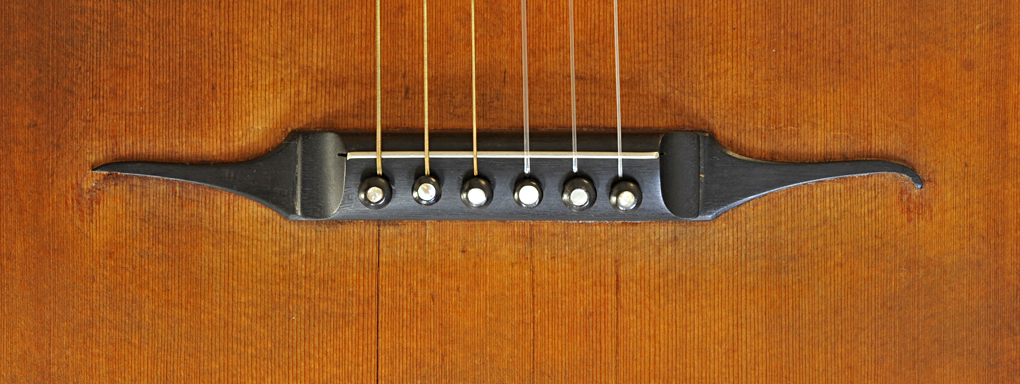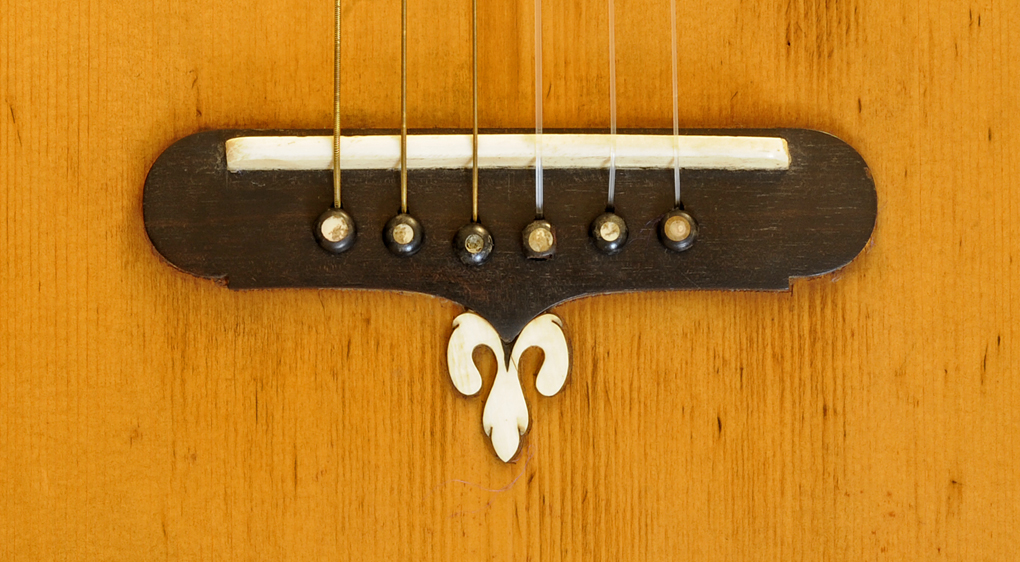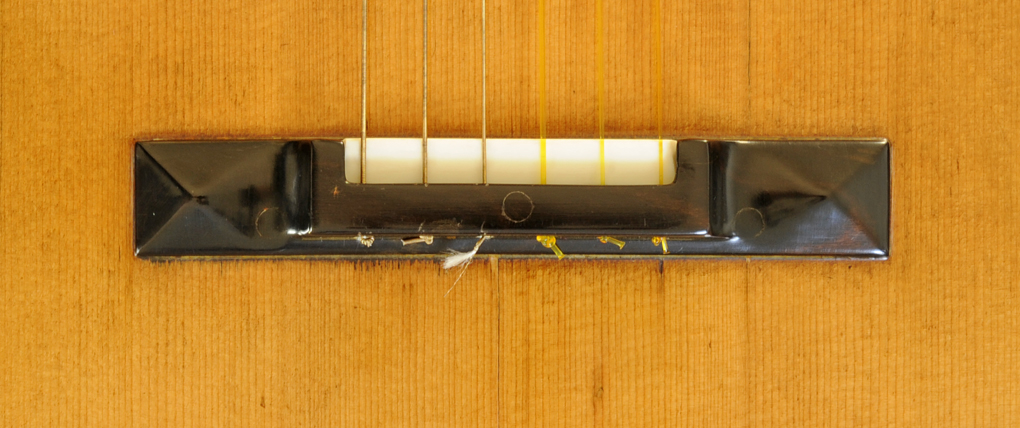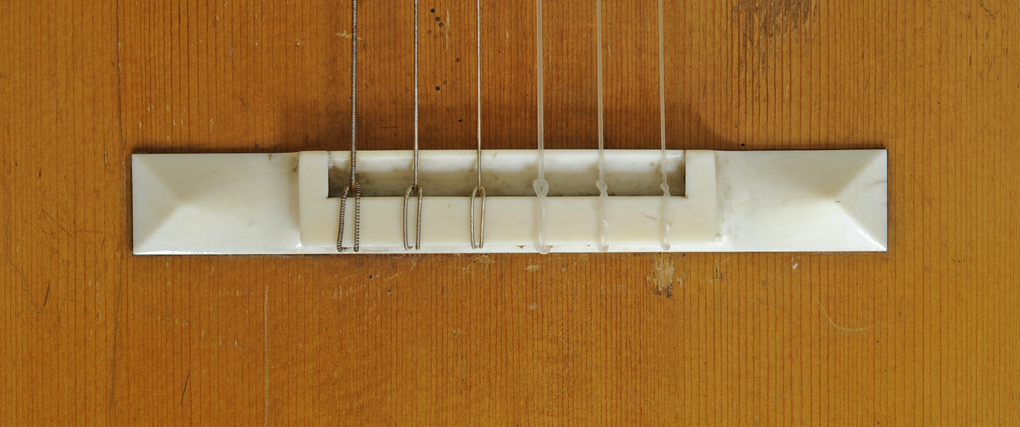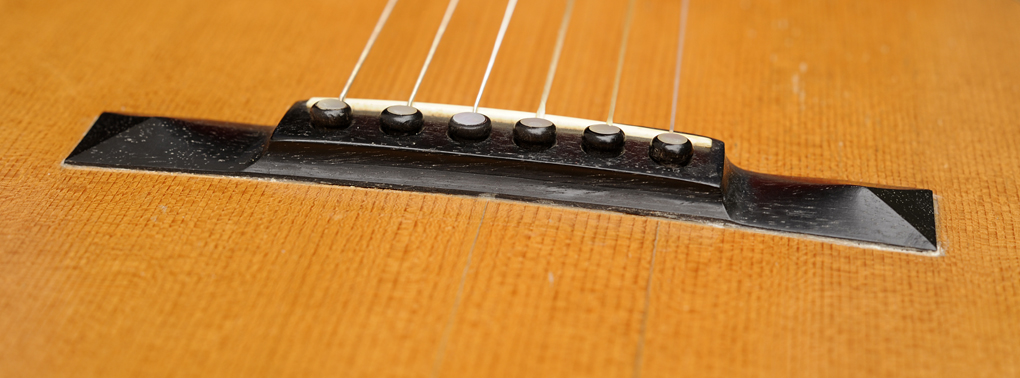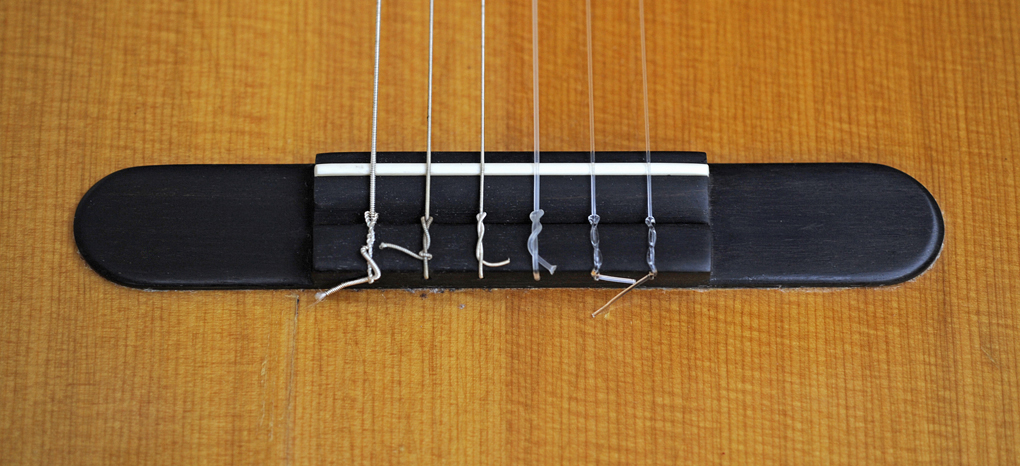ALL TIED UP
The Evolution of Tie Bridges on Martin Guitars
While the tie style bridge is generally associated with gut or nylon string guitars and the pin style bridge is generally associated with steel string guitars, Martin used pin style bridges on their earliest gut strings guitars and on most Martins for close to 100 years before introducing steet string guitars.
The "moustache" bridge, with bridge pins and a fretwire saddle, appeared on early Stauffer and Martin "Stauffer Style" guitars from the 1830's.
A number of early Martin and Martin & Coupa guitars, such as this one, have the "badge" or "shield" style bridge, in either ebony or ivory, here seen with an added ivory pendant, also with bridge pins. Some ivory versions have a fretwire saddle similar to those on the Stauffer "moustache" bridges.
The first "tie" style bridges, in the pyramid style, appeared on Martin and Martin & Coupa guitars in the 1940's, on the "Spanish" guitars Martin was beginning to make in the style of those made by Torres in Spain, with cedar necks and French heels as opposed to ebonized necks and "ice cream cone" heels.
Early versions, such as on this Martin & Coupa, are ebony with an ivory saddle:
This Spanish style Martin, probably slightly later, has an ivory version of the tie style pyramid bridge.
The ivory tie style pyramid bridge is 25/32" x 5 29/32". The ebony tie style pyramid bridge above is a quite differently proportioned 29/32" x 1 27/32"
The earliest pin style pyramid bridge is only a slight step away from the "tie style" pyramid, with a similar "lipped" or scooped back.
In other words, all guitars were strung with gut strings, and it was those first built in the Spanish style that had tie bridges vs. pin bridges.
By the middle of the 19th century, the wires were crossed, and fan braces, a key feature of the Spanish influence were associated with ebonized necks, X braces were associated with cedar necks, and even those guitars specifically made for playing in the classical style, such as those made for Vadah Olcott-Bickford, sported pin bridge.
Even the early "G" models, made with fan braces for classical style playing, featured pin style bridges.
Martin revived the tie style bridge for it's later classical guitars such as the 000-28C of the 1960's
1962 000-28C
Notes:
a) Pyramid bridges should have a curved slope on the inside portion of the pyramid. Bad copies have four straight edges. The saddles were not slanted until ( ), and they were also drop in for 80 years until 1919. The through saddle didn't start until 1919 (1920?) and lasted until about 1968 when they went back to the drop-in style. I have seen a 1920 0-28 with a drop in saddle.
b) Size:
1. Size 1 and larger from all years have bridges 6" long
2. Size 2 and 2 1/2 Martins have bridges 5 7/8" to 5 3/4" long. At least until the 1890s.
I see that the lipped bridges I have are 27/32" x 5 27/32". Most of the early round back pyramids are 7/8" x 5 7/8".
PYRAMID BRIDGE LENGTH
The earliest pyramid bridges, at least going back to the 1850's, are 5 7/8" long.
From the mid 1890's through the 1930 OM, they are 6" long.
Some from the 1870's to the 1890's are 5 3/4" long.
PYRAMID BRIDGE WIDTH
Most before 1900 are roughly 7/8" wide. Some from the 1840s or 1850s are 13/16" wide.
Most after 1900 are 1" wide.
I have one from 1926 that is 15/16" wide.
PYRAMID BRIDGE WINGS
The average length of the wings on most pyramid bridges is roughly 1 3/8"
During the 1880's and 1890's, however, there is more variation, as much as from 1 1/4" to 1 1/2"
On the earlier 7/8" wide bridges, the wings have a very long, narrow, elegant appearance, with a gentle curve to the inside angles of the pyramids, that looks nothing at all like the harsh angles found on many of the bad copies.
I found no difference between the dimensions of ivory and ebony bridges from the same period.
It's interesting that the earlier years have more consistency in length than the middle years. Some time ago I did a survey of the body dimensions of my early guitars, and I found the earliest years to be precise, while the middle years had much more variation.
This 1885 0-34 bridge is the longest and narrowest of the lot, 6" long, 7/8" wide, with 1 1/2" long wings:
STRING SPACING
It appears that Martin was moving to 2 5/16" spacing on size 2 guitars, and 2 3/8" spacing on size 1.
(all listed are pre-1867 unless otherwise noted)
Original Stauffer - moustache bridge. 2 5/16"
Hudson Street - replacement ivory pin bridge. 2 5/16"
Early fancy Spanish size 3 - ivory tie bridge. 2 7/16"
Ivory fingerboard Stauffer headstock - replacement ebony pin bridge. (I've wondered if the original was ivory pin or tie). New bridge plate. 2 1/4"
Early Spanish Martin & Coupa - ebony tie bridge with ivory inset 2 9/32"
Koa Martin & Coupa - shield shape bridge, pins in arc. 2 5/16"
LIGHT DIAMOND BACKSTRIPS/ Spanish foot
Hybrid X 1-28 2 3/8"
LIGHT DIAMOND BACKSTRIPS/ split neck blocks, old marquetry end
2-23 2 1/4"
2-24 2 5/16"
2-24 2 5/16"
2-20 2 5/16
DARK DIAMOND BACKSTRIPS
2-23 2 5/16" (solid block)
2- 21 2 5/16" (split block)
vintagemartin.com
To See Robert Corwin's Classic Photography of Folk and Roots Musicians, visit:
For Information on Photography for
Exhibition, Publication, CD's, Promotion, Web Pages, Tour Books,
to Purchase Photographic Prints, or
If You Have Questions or Suggestions About This Web Site or Vintage Martin Guitars:
e-mail: Robert Corwinentire site copyright ©1998 through 2009 Robert Corwin/Photo-Arts. All rights reserved.
